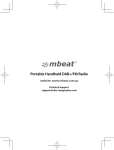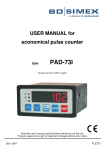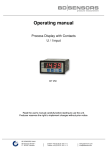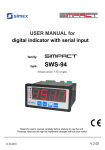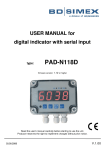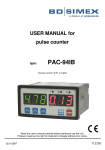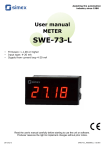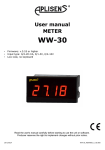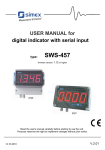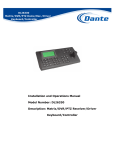Download Quick Start Operating manual
Transcript
Quick Start Operating manual Process Display with Contacts U/I input ITC 450 Read the user’s manual carefully before starting to use the unit. Producer reserves the right to implement changes without prior notice. Table of Contents 1. Basic requirements and user safety 1 2. General Characteristics 2 3. Technical Data 2 4. Device installation 4 4.1 Unpacking 4 4.2 Assembly 4 4.3 Connection method 6 4.4 Maintenance 12 5. Front panel description 12 6. Principle of operation 13 7. Device programming 12 7.1 Programming menu 13 7.2 Parameters edition 14 7.2.1. Numeric parameters (digit change mode) 14 7.2.2. Numeric parameters (slide change mode) 14 7.2.3. Switch parameters (―LIST‖ type) 15 7.3. Menu Structure 8. ITC 450 Quick Start Operations Manual (Step by Step) 16 18 Explanation of symbols used in the manual: This symbol denotes especially important guidelines concerning the installation and operation of the device. Not complying with the guidelines denoted by this symbol may cause an accident, damage or equipment destruction. IF THE DEVICE IS NOT USED ACCORDING TO THE MANUAL THE USER IS RESPONSIBLE FOR POSSIBLE DAMAGES. This symbol denotes especially important characteristics of the unit. Read any information regarding this symbol carefully. 1. Basic requirements and user safety The manufacturer is not responsible for any damages caused by inappropriate installation, not maintaining the proper technical condition and using the unit against its destination. Installation should be conducted by qualified personnel only. During installation all available safety requirements should be considered. The installer is responsible for executing the installation according to this manual, local safety and EMC regulations. The unit must be properly set-up, according to the application. Incorrect configuration can cause defective operation, which can lead to unit damage or an accident. If in the case of a defect of unit operation there is a risk of a serious threat to the safety of people or properly additional, independent systems and solutions to prevent such a threat must be used. The unit uses dangerous voltage that can cause a lethal accident. The unit must be switched off and disconnected from the power supply prior to starting installation of troubleshooting (in the case of malfunction). Neighboring and mating equipment must meet the requirements of appropriate standards and regulations concerning safety and be equipped with adequate anti- overvoltage and anti-interference filters. Do not attempt to disassemble, repair or modify the unit yourself. The unit has no user serviceable parts. Units, in which a defect was stated must be disconnected and submitted for repairs at an authorized service center Do not use the unit in explosion hazard areas. Do not use the unit in areas with significant temperature variations, exposed to condensation or icing. Do not use the unit in areas exposed to direct sunlight. Icon Process Controls Ltd| P (905) 469 9283 | F (905) 469 9159 | [email protected] | www.iconprotech.com 1 The unit is designed for operation in an industrial environment and must not be used in a household environment or similar. 2. General Characteristics The ITC 450 meter is equipped with one current input 0-20 / 4-20 mA and one voltage input 0-5/15/0-10/2-10 V. The Current input additionally has an overcurrent protection circuit, which protects the standard resistor. The selection of active input is realized by software, and selected input can be changed at any time. Additionally the ITC 450 allows user to select a conversion characteristic of several kinds: linear, square, square root, and user defined (max. 20 points length). Result is showed on 4-digit LED display. Displayed values range can be selected by user, from -999 to 9999, plus decimal point. The device can be equipped with one or two relay (or OC type) outputs. Device ITC 450 is equipped with RS-485 / Modbus RTU communication interface and sensor supply output. The meter can be ordered in two power supply versions. ITC 450 can be used for controlling and regulation of processes need proportional and threshold control like: temperature processes (heating or cooling), valves controlling or other. 3. Technical Data Power supply voltage External fuse (required) Power consumption Current / Voltage Input Current input resistance Voltage input resistance Accuracy (25 °C) standard: 85 ... 260 VAC/DC option: 19 ... 50 VDC; 16 ... 35 VAC T - type, max. 2 A Max 4.5 VA or W 0/4 … 20 mA 0/1 … 5 V, 0/2 … 10 V < 65 Ω (typical 55 Ω) > 50 kΩ ± 0.1 % FSO tolerance band (0 … 50 °C): max. 0.25 % FSO Icon Process Controls Ltd| P (905) 469 9283 | F (905) 469 9159 | [email protected] | www.iconprotech.com 2 Display range Accepted prolonged input overload Contact Switching voltage Switching current Transducer supply Communication interface Transmission speed Display Data memory Type of protection Housing Housing material Housing dimensions Mounting hole Assembly depth Panel thickness Operating temperature Storage temperature Screw tightening Max. connection leads diameter Electrical safety EMC -999 … 9999, plus decimal point 20 % 1 or 2 SPST-relay max. 250 VAC max. 1 A (cos φ= 1) 24 V + 5 %, -10 % / max. 100 mA RS-485 (Modbus RTU) 1200 … 115200 bit/sec 4-digit LED display, red / green, 4 x 13 mm non-volatile memory, EEPROM type IP 65 (front foil) panel NORYL - GFN2S E1 72 x 36 x 95 mm 69 x 33 mm 102 mm max. 5 mm 0 ... 50 °C -10 ... 70 °C max. torque 0.5 Nm 2.5 mm2 EN 61010-1 EN 61326 This is a class A unit. In housing or a similar area it can cause radio frequency interference. In such cases the user can be requested to use appropriate preventive measures. Icon Process Controls Ltd| P (905) 469 9283 | F (905) 469 9159 | [email protected] | www.iconprotech.com 3 4. Device installation The unit has been designed and manufactured in a way assuring a high level of user safety and resistance to interference occurring in a typical industrial environment. In order to take full advantage of these characteristics installation of the unit must be conducted correctly and according to the local regulations. Read the basic safety requirements on page 3 prior to starting the installation. Ensure that the power supply network voltage corresponds to the nominal voltage stated on the unit’s identification label. The load must correspond to the requirements listed in the technical data. All installation works must be conducted with a disconnected power supply. Protecting the power supply clamps against unauthorized persons must be taken into consideration. 4.1 Unpacking After removing the unit from the protective packaging, check for transportation damage. Any transportation damage must be immediately reported to the carrier. Also, write down the unit serial number on the housing and report the damage to the manufacturer. Attached with the unit please find: - User’s manual - Assembly brackets – 2 pieces 4.2Assembly The unit is designed for mounting indoor inside housing (control panel, switchboard) assuring appropriate protection against electric impulse waves. Metal housing must be connected to the ground in a way complying with governing regulations. Disconnect the power supply prior to starting assembly. Check the correctness of the performed connections prior to switching the unit on. In order to assembly the unit, a 69 x 33 mm mounting hole (Figure 4.1) must be prepared. The thickness of the material of which the panel is made must not exceed 5 mm. when preparing the mounting hole take the grooves for catches located on both sides of the housing into consideration (Figure 4.1). place the unit in the mounting hole inserting it from the front side of the panel, and then fit it using the brackets (Figure 4.2). The minimum distances between assembly holes’ axes – due to the thermal and mechanical conditions of operation – are 91 x 57 mm (Figure 4.3). Icon Process Controls Ltd| P (905) 469 9283 | F (905) 469 9159 | [email protected] | www.iconprotech.com 4 Fig. 4.1. mounting hole dimensions Fig. 4.2. installing of brackets, and dimensions of connectors Icon Process Controls Ltd| P (905) 469 9283 | F (905) 469 9159 | [email protected] | www.iconprotech.com 5 Fig. 4.3. minimum distances when assembly of a number of units 4.3. Connection method Caution Installation should be conducted by qualified personnel. During installation all available safety requirements should be considered. The fitter is responsible for executing the installation according to this manual, local safety and EMC regulations. The unit is not equipped with an internal fuse or power supply circuit breaker. Because of this an external time-delay cut-out fuse with minimal possible nominal current value must be used (recommended bipolar, max. 2 A) and a power supply circuit-breaker located near the unit. In the case of using a monopolar fuse it must be mounted on the phase cable (L). The power supply network cable diameter must be selected in such a way that in the case of a short circuit of the cable from the side of the unit the cable shall be protected against destruction with an electrical installation fuse. Wiring must meet appropriate standards and local regulations and laws. In order to secure against accidental short circuit the connection cables must be terminated with appropriate insulated cable tips. Tighten the clamping screws. The recommended tightening torque is 0.5 Nm. Loose screws can cause fire or defective operation. Over tightening can lead to damaging the connections inside the units and breaking the thread. In the cause of the unit being fitted with separable clamps they should be inserted into appropriate connections in the unit, even if they are not used for any connections. Unused clamps (marked as n.c.) must not be used for connecting any connecting cables (e.g. as bridges), because this can cause damage to the equipment or electric shock. If the unit is equipped with housing, covers and sealing packing, protecting against water intrusion, pay special attention to their correct tightening or clamping. In the case of any doubt consider using additional preventive measures (covers, roofing, seals, etc.). Carelessly executed assembly can increase the risk of electric shock. After the installation is completed do not touch the unit’s connections when it is switched on, because it carries the risk of electrical shock. Icon Process Controls Ltd| P (905) 469 9283 | F (905) 469 9159 | [email protected] | www.iconprotech.com 6 Due to possible significant interference in industrial installations appropriate measures assuring correct operation of the unit must be applied. To avoid the unit of improper indications keep recommendations listed below. Avoid common (parallel) leading of signal cables and transmission cables together with power supply cables and cables controlling induction loads (e.g. contactors). Such cables should cross at the right angle. Contactor coils and induction loads should be equipped with anti-interference protection systems, e.g. RC-type. Use of screened signal cables is recommended. Signal cable screens should be connected to the earth only at one of the ends of the screened cable. In the case of magnetically induced interference the use of twisted couples of signal cables (so-called ―spirals‖) is recommended. The spiral (best if shielded) must be used with RS485 serial transmission connections. In the case of interference from the power supply side the use of appropriate antiinterference filters is recommended. Bear in mind that the connection between the filter and the unit should be as short as possible and the metal housing of the filter must be connected to the earth with the largest possible surface. The cables connected to the filter output must not run in parallel with cables with interference (e.g. circuits controlling relays or contactors). Connectors of power supply voltage and measurement signals are executed using the screw connections on the back of the unit’s housing. Fig. 4.4. method of cable insulation replacing and cable terminals All connections must be made while power supply is disconnected! Icon Process Controls Ltd| P (905) 469 9283 | F (905) 469 9159 | [email protected] | www.iconprotech.com 7 Fig. 4.5. Terminals description (relay outputs) Fig. 4.6. Terminals description (OC-type outputs) Fig. 4.7. Connection of 2-wire current converters Icon Process Controls Ltd| P (905) 469 9283 | F (905) 469 9159 | [email protected] | www.iconprotech.com 8 Fig. 4.8. Connection of 3-wire current converters Fig. 4.9. Connection of voltage converters Icon Process Controls Ltd| P (905) 469 9283 | F (905) 469 9159 | [email protected] | www.iconprotech.com 9 Fig. 4.10 Connection of power supply and relays Contacts of relay outputs are not equipped with spark suppressors. While use the relay outputs for switching of inductive loads (coils, contactors, power relays, electromagnets, motors etc.) it is required to use additional suppression circuit (typically capacitor 47 nF / min. 250 VAC in series with 100R/5W resistor), connected in parallel to relay terminals or (better) directly on the load. In consequence of using the suppression circuit, the level of generated electromagnetic disturbances is lower, and the life of relay contacts rises. Icon Process Controls Ltd| P (905) 469 9283 | F (905) 469 9159 | [email protected] | www.iconprotech.com 10 Fig. 4.11. Examples of suppression circuit connection: a) to relay terminals; b) to the inductive load Fig. 4.12. Example of OC-type outputs connection Icon Process Controls Ltd| P (905) 469 9283 | F (905) 469 9159 | [email protected] | www.iconprotech.com 11 4.4 Maintenance The unit does not have any internal replaceable or adjustable components available to the user. Pay attention to the ambient temperature in the room where the unit is operating. Excessively high temperatures cause faster ageing of the internal components and shorten the fault-free time of unit operation. In cases where the unit gets dirty do not clean with solvents. For cleaning use warm water with small amount of detergent or in the case of more significant contamination ethyl or isopropyl alcohol. Using any other agents can cause permanent damage to the housing. 5. Front panel description Symbols and functions of push-buttons: Symbol used in the manual: [ESC/MENU] Functions: enter to main menu (press and hold by at least 2 sec.) exit the current level and enter to previous menu (or measure mode) cancel the changes made in parameter being edited Symbol used in the manual: [ENTER] Functions: start to edit the parameter enter to the sub-menu confirmation of changes made in parameter being edited Symbol used in the manual: [^] [v] Functions: change of the present menu modification of the parameter value change of the display mode Icon Process Controls Ltd| P (905) 469 9283 | F (905) 469 9159 | [email protected] | www.iconprotech.com 12 6. Principle of operation After turning the power supply on, device ID and software version are showed on the display, next the controller goes to the measurement mode. 7. Device programming The device menu allow user to set all parameters connected to operation of measurement input, control modes, critical situations behavior, communication via RS-485 and access settings. The meaning of the particular parameters is described in paragraph MENU DESCRIPTION. Some of the parameters can be accessed without menu entering (quick view mode). After pressing [^] or [v] button, name of the threshold (e.g. “rEL1”) and his value will be displayed on the display in alternating mode. If [^] or [v] will be pressed in 5 sec again, the next threshold will be displayed, else the device comes back to the measurement mode. If a free access is enabled (see description of “SECu” menu), user can change the value of particular threshold pressing button [ENTER] (see: PARAMETERS EDITION). If particular parameter has been changed and confirmed in quick view mode, its new value is displayed in alternating mode with parameter name by few seconds. Confirmed changes may be checked or user can switch viewed parameter pressing [^] or [v] button. 7.1. Programming menu To enter main menu (being in the measurement mode) operator must to press and hold at least 2 sec. [ESC/MENU] button. If the user password is defined (see parameter “Scod”, menu “SECU”), operator have to enter correct one before proceeding to menu options. Entering of the passwords is similar to the edition of numeric parameters (see: PARAMETERS EDITION), however presently editing digit is showed only on the display, other digits are replaced by ―-― sign. After entering of last digit of the password first menu position will be displayed (if the password is correct) or warning “Err” in other case. Pay attention when device parameters are being changed. If it is possible, turn off controlled installation (machine). Icon Process Controls Ltd| P (905) 469 9283 | F (905) 469 9159 | [email protected] | www.iconprotech.com 13 Functions of the buttons while sub-menu and parameter choice: Selection of sub-menu or parameter for editing. Name of selected item (sub-menu or parameter) is displayed. Operation of[ENTER]button depend on present menu position: If the name of some sub-menu is displayed – enter this submenu; Name of the first parameter (or next level sub-menu) is displayed If the name of some parameter is displayed – enter the edition of this parameter; present value of the parameter is displayed. [ESC/MENU]button allow user to exit present menu level and goes to upper level menu (or measurement mode). After about 1 min. since last use of the buttons, device exits the menu mode and returns to the measurement mode (only if no parameters are in editing mode). 7.2 Parameters edition To start edition of any parameter use should select name of desired one using [^] [v] buttons and then press [ENTER]. 7.2.1. Numeric parameters (digit change mode) Numerical parameters are displayed as decimal numbers. The mode of its new value entering depends on chosen edit method (see parameter ,,Edit‖). In mode ―by digit‖ (,,Edit‖ = ―dig‖) pressing one of the keys [^] or [v] causes change of current position (flashing digit) or the sign (+/-). Short pressing of the [ENTER] button causes change of the position (digit). Please [ENTER] at least 2 seconds to accept the changes, after that question “SEt?” is displayed, and user must to confirm (or cancel) the changes. To conform changes (and story it in EEPROM) press [ENTER] button shortly after “SEt?” is displayed. To cancel the changes press [ESC] button shortly after “SEt?” is displayed. After that device returns to the menu. 7.2.2. Numeric parameters (slide change mode) In ―slide change‖ mode (,,Edit‖=‖Slid‖), buttons [^] and [v] has different functions. To increase edited value press (or press and hold) [^] button only, the increasing became quickest as long as button [^] is pressed. To slow down the increasing, button [v] can be used. If [v] is pressed shortly (and button [^] is still pressed), increasing slow down for a moment only, if [v] is pressed and help while button [^] is still pressed the increasing slow down and will be kept on lower speed. Icon Process Controls Ltd| P (905) 469 9283 | F (905) 469 9159 | [email protected] | www.iconprotech.com 14 To decrease edited value press (or press and hold) [v] button only. The decreasing became quickest as long as button [v] is pressed. To slow down the decreasing, button [^] can be used. If [^] is pressed shortly (and button [v] is still pressed), decreasing slow down for a moment only, if [^] is pressed and held while button [v] is still pressed the decreasing slow down and will be kept on lower speed. Press [ENTER] at least 2 seconds to accept the changes, after that question “Set?” is displayed, and user must to confirm (or cancel) the changes. To conform changes (and story it in EEPROM) press [ENTER] button shortly after “SEt?” is displayed. To cancel the changes press [ESC] button shortly after “SEt?” is displayed. After that device returns to the menu. 7.2.3. Switch parameters (“LIST” type) Switch parameters can be described as sets of values (lists) out of which only one of the options available on the list can be selected for the given parameter. Options of switching parameter are selected using [^], [v] keys. Short pressing of [ENTER] causes in displaying of the acknowledge question (“SEt?”). If key [ENTER] is pressed again, the changes are accepted, stored in EEPROM end the edition process finished. Pressing the key [ESC] after “SEt?” causes in cancelling of made changes and returning to menu. Functions of the buttons when editing numeric and switching parameters: While editing numeric parameter: Change of current (flashing) digit Slide change of value (acceleration, deceleration, direction change) While editing switch parameter – selection of switch parameter. If numerical parameter is being edited, a short press of [ENTER] button change edited position. A long press of [ENTER] button (at least 2 sec.) cause of display a “SEt?” ask, which allow user to make sure if change of the parameter value is correct. If switch parameter is being edited, a short press of [ENTER] button causes of display a “SEt?” ask. When [ENTER] button is pressed again (while “SEt?” is displayed) the new value of the parameter is stored in EEPROM memory. Pressing this button operator can cancel the changes done up to now (if they were not approved by [ENTER] button after the “SEt?” ask) and come back to menu. Icon Process Controls Ltd| P (905) 469 9283 | F (905) 469 9159 | [email protected] | www.iconprotech.com 15 7.3. Menu structure Icon Process Controls Ltd| P (905) 469 9283 | F (905) 469 9159 | [email protected] | www.iconprotech.com 16 Icon Process Controls Ltd| P (905) 469 9283 | F (905) 469 9159 | [email protected] | www.iconprotech.com 17 8. ITC 450 Quick Start Operations Manual (Step by Step) ITC 450 Quick Start Operations Manual (Step by Step) PROGAMMING RELAYS Press ESC/Menu Button for 3 Seconds (Enter Security Code if Required) PRESS DOWN ARROW (Relay 1 Appears on Display) PRESS ENTER BUTTON (SETP Appears on Display) PRESS ENTER BUTTON (Relay Set-Point Number Appears on Display) PRESS UP or DOWN ARROW TO INCREASE or DECREASE NUMBER TO DESIRED SETPOINT (When Desired Number Appears Press & Hold Enter (2 Sec) PRESS DOWN ARROW TO SELECT RELAY PARAMETERS (ON-OFF, HYSTERISIS, Mode, Time, Unit, Alarm) ( SETP Appears on Display) Repeat Steps to Set-Up 2nd, if Required PROGRAMING 4-20mA INPUT Press ESC/Menu BUTTON (3 Sec) (Enter Security Code if Required) PRESS DOWN ARROW (inPT Appears on Display) PRESS ENTER BUTTON (tyPE Appears on Display) PRESS DOWN ARROW (4X) (Lo C Appears on Display) PRESS ENTER BUTTON –(4mA) (ALL ZERO’s (0000)-This is Standard = 4mA Set-Point) PRESS ESC/MENU BUTTON PRESS DOWN ARROW (Hi C Will Appear on Display) PRESS ENTER BUTTON—(20mA) (Numbers will Appear-Change Using Up/Down Arrows to Set Desired 20mA Set-Point) PRESS ENTER—(Hold 3 Sec) PRESS ESC/MENU to Return to Main Menu Icon Process Controls Ltd| P (905) 469 9283 | F (905) 469 9159 | [email protected] | www.iconprotech.com 18




















